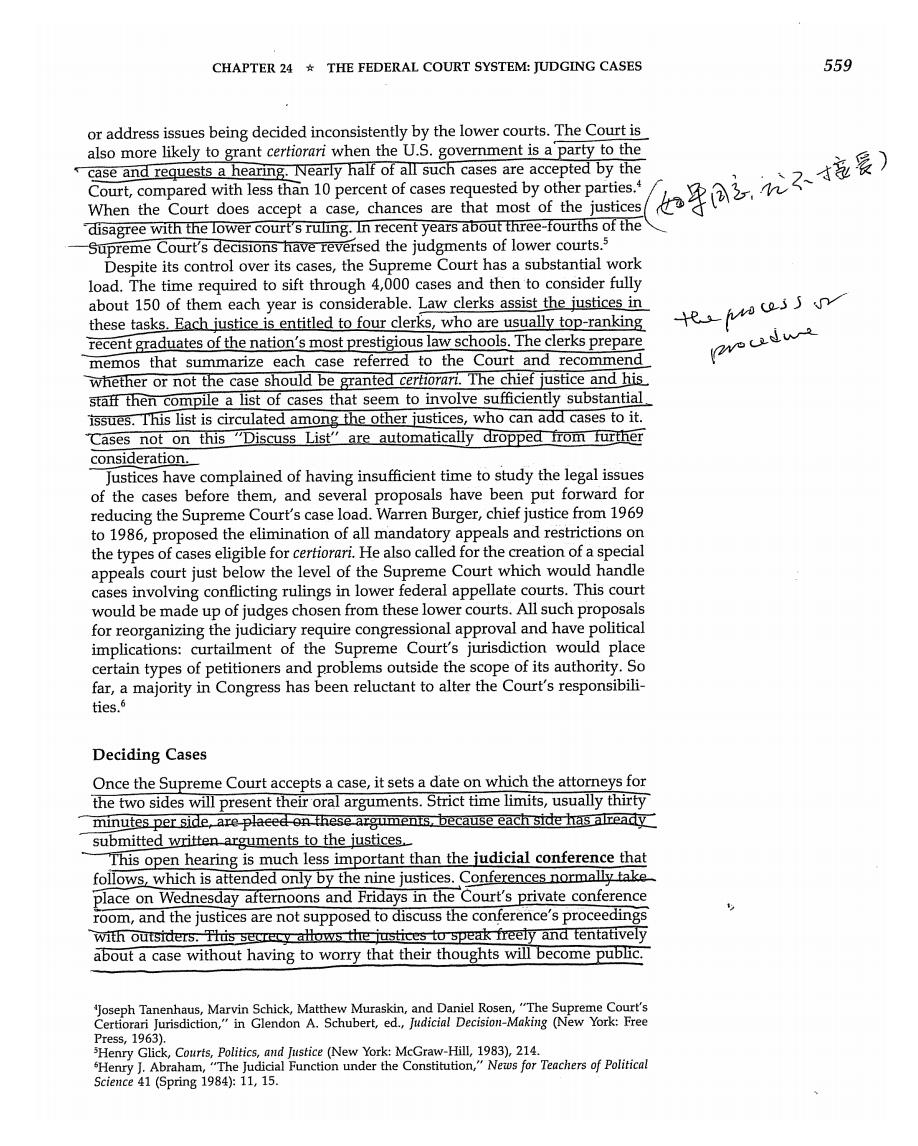正在加载图片...

CHAPTER 24 THE FEDERAL COURT SYSTEM:JUDGING CASES 559 or address issues being decided inconsistently by the lower courts.The Court is also more likely to grant certiorari when the U.S.government is a party to the case and requests a hearing.Nearly half of all such cases are accepted by the Court,compared with less than 10 percent of cases requested by other parties. When the Court does accept a case,chances are that most of the justices 学a名,不寸意爱) disagree with the lower court's ruling.In recent years about three-fourths of the Supreme Court's decisions have reversed the judgments of lower courts.5 Despite its control over its cases,the Supreme Court has a substantial work load.The time required to sift through 4,000 cases and then to consider fully about 150 of them each year is considerable.Law clerks assist the justices in these tasks.Each justice is entitled to four clerks,who are usually top-ranking 代ofivo cass v recent graduates of the nation's most prestigious law schools.The clerks prepare rocdu memos that summarize each case referred to the Court and recommend whether or not the case should be granted certiorari.The chief justice and his staff then compile a list of cases that seem to involve sufficiently substantial issues.This list is circulated among the other justices,who can add cases to it. Cases not on this "Discuss List"are automatically dropped from further consideration. Justices have complained of having insufficient time to study the legal issues of the cases before them,and several proposals have been put forward for reducing the Supreme Court's case load.Warren Burger,chief justice from 1969 to 1986,proposed the elimination of all mandatory appeals and restrictions on the types of cases eligible for certiorari.He also called for the creation of a special appeals court just below the level of the Supreme Court which would handle cases involving conflicting rulings in lower federal appellate courts.This court would be made up of judges chosen from these lower courts.All such proposals for reorganizing the judiciary require congressional approval and have political implications:curtailment of the Supreme Court's jurisdiction would place certain types of petitioners and problems outside the scope of its authority.So far,a majority in Congress has been reluctant to alter the Court's responsibili- ties.6 Deciding Cases Once the Supreme Court accepts a case,it sets a date on which the attorneys for the two sides will present their oral arguments.Strict time limits,usually thirty minutes per side,are placed on these arguments,because each side has already submitted written arguments to the justices. This open hearing is much less important than the judicial conference that follows,which is attended only by the nine justices.Conferences normally take place on Wednesday afternoons and Fridays in the Court's private conference room,and the justices are not supposed to discuss the conference's proceedings with outsiders.This secrecy allows the justices to speak freely and tentatively about a case without having to worry that their thoughts will become public. Joseph Tanenhaus,Marvin Schick,Matthew Muraskin,and Daniel Rosen,"The Supreme Court's Certiorari Jurisdiction,"in Glendon A.Schubert,ed.,Judicial Decision-Making (New York:Free Press,1963). SHenry Glick,Courts,Politics,and Justice (New York:McGraw-Hill,1983),214. Henry J.Abraham,"The Judicial Function under the Constitution,"News for Teachers of Political Science 41 (Spring 1984):11,15